Iowa’s Legislature isn’t doing public schools justice in new spending bill, and Iowa’s youth will pay.
Jacob Prall
One day after recess, my teacher, Mrs. Larson, began passing around that week’s spelling quiz. “Ignore what’s on the back of your quiz, class,” she said, and of course, 30 first-graders turned their papers over to see what was the big deal. Our spelling tests were adorned with math equations — symbols we had yet to see, let alone master. Mrs. Larson had to give us some answers. What were all these squiggles, huh? “We can’t afford new paper, so we’re recycling from the fifth-graders. Now, let’s take our test.”
Budget cutbacks are nothing new for Iowa public schools. Over the last decade, the state Legislature and Governor’s Office have done a poor job at keeping Iowa’s public schools well-funded. The primary issue is their refusal to increase education spending to keep up with inflation.
A new spending bill is kicking around both chambers of the GOP-controlled Legislature, and Republicans have settled on a plan. They support a 1 percent increase in basic state aid to Iowa’s school districts. Democrats, on the other hand, are univerally opposed. And they have reason to be — according to the Bureau of Labor Statistics, inflation in the Midwest hit 1.7 percent last year, more than the proposed increase in spending. Democrats are also concerned that insufficient funding will cause an increase in property taxes in 183 districts, affecting rural communities the most.
RELATED: Prall: Branstad’s education plan is near-sighted
The Republicans in the Statehouse counter the Democrats’ points with a question: Where will you get the money to pay for a spending increase? And it’s a fair question. Democrats, in response, point to the broken promise made by the Governor’s Office to add 200,000 new jobs to Iowa’s economy and increase family incomes by 25 percent. If those figures had become a reality, state coffers would have some breathing room. Further, Democrats think the millions of dollars being spent by Iowa’s taxpayers to subsidize the development of property for the largest, most profitable companies in the world — Microsoft, Google, and Apple — is wasteful and better spent on Iowa’s future. Republicans will have a difficult time defending corporate welfare over education to the public, but at the end of the day, the children affected by insufficient education spending in Iowa are the ones who pay.
In response to Democratic criticisms, the Iowa House of Representatives is reconsidering a bill passed by Iowa’s Senate a while back. The bill aims to equalize transportation costs across school districts with a $10 million investment, and it will supplement the lackluster basic aid spending increase. Transportation costs are a serious problem in Iowa; cost per student can vary wildly across the state. Transporting a student to school can cost anywhere from $10 at West Burlington Independent School District to as much as $1,000 at North Winneshiek School District, according to the Iowa Association of School Boards. The bill is too late for the North Winneshiek district, which had to consolidate because of the high costs of transportation. Consolidation means bigger classroom sizes, fewer teachers, and a strain on educational resources.
RELATED: Iowa Senate passes bill that would slash funds for higher education
Another measure seeking to solve the problem of high transportation costs is floating around the House as well. There is a push underway to extend the maximum time bus routes can drive students. While this would allow school districts to save money, the resulting increase in time students spend on the bus is not worth it. Students could be sleeping, studying, playing, or spending time with family in those crucial minutes. It seems a supplementary spending bill is the best solution.
At the end of the day, Iowa’s Republicans are not prioritizing Iowa’s youth. Education is essential to the future of Iowa as a state; a well educated-populace raises GDP and allows Iowans to compete in a global economy. Education is an excellent use of taxpayer dollars, and while reusing paper might be cost-effective, it is emblematic of shortcuts taken by Iowa’s public schools because of funding shortfalls. These shortcuts and shortfalls ultimately shortchange Iowa’s young and hopeful students.










